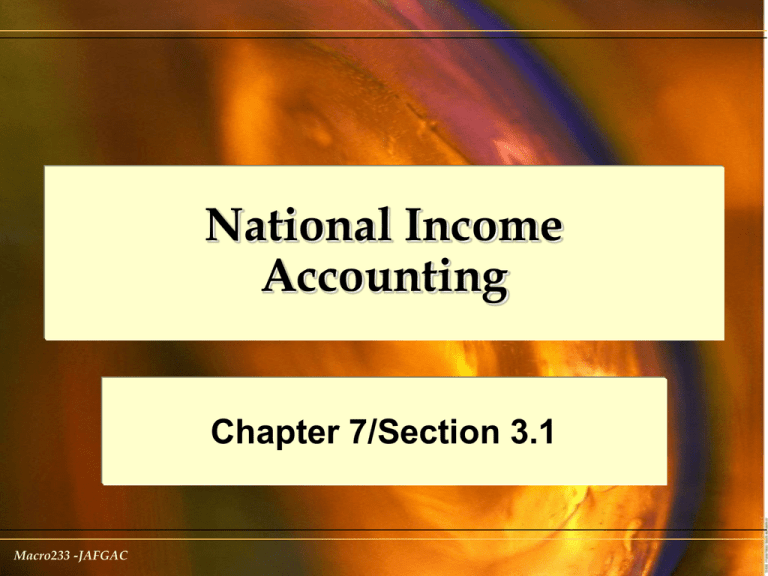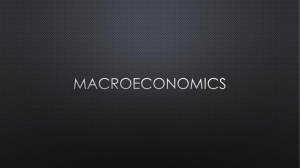
National Income
Accounting
Chapter 7/Section 3.1
Macro233 -JAFGAC
Laugher Curve
Three econometricians went out hunting,
and came across a large deer.
The first econometrician fired, but missed,
by a yard to the left.
Econ2333 - JAFGAC
Laugher Curve
The second econometrician fired, but also
missed, by a yard to the right.
The third econometrician didn't fire, but
shouted in triumph, "We got it! We got it!"
Econ2333 - JAFGAC
National Income Accounting
National income accounting – a set of
rules and definitions for measuring
economic activity in the aggregate
economy – that is, in the economy as a
whole.
National income accounting is a way of
measuring total, or aggregate production.
Econ2333 - JAFGAC
Measuring Total Economic
Output of Goods and Services
Gross Domestic Product (GDP) is the
total value of all final goods and services
produced in an economy in a one-year
period.
It is the single most-used economic
measure.
Econ2333 - JAFGAC
Measuring Total Economic
Output of Goods and Services
Gross National Product (GNP) is the
aggregate final output of citizens and
businesses of an economy in one year.
Econ2333 - JAFGAC
Measuring Total Economic
Output of Goods and Services
GDP is output produced within a country’s
borders.
GNP is output produced by a country’s
citizens.
Econ2333 - JAFGAC
Measuring Total Economic
Output of Goods and Services
Net foreign factor income is added to GDP
to move from GDP to GNP.
Net foreign factor income is the income from
foreign domestic factor sources minus foreign
factor incomes earned domestically.
Econ2333 - JAFGAC
Calculating GDP
Calculating GDP requires adding together
million of goods and services.
All goods and services produced by an
economy must be weighted.
Each good and service is multiplied by its
price.
Econ2333 - JAFGAC
Calculating GDP
Once quantities of a particular good or
service are multiplied by its price, we arrive
at a value measure of the good or service.
All the units of value are added to arrive at
GDP.
Econ2333 - JAFGAC
GDP Is a Flow Concept
GDP is a flow concept.
It is reported quarterly on an annualized
basis.
Annualized basis – quarterly figures are used
to estimate total output for the whole year.
Econ2333 - JAFGAC
GDP Is a Flow Concept
The store of wealth is a stock concept.
Wealth accounts – a balance sheet of an
economy’s stocks of assets and liabilities.
Econ2333 - JAFGAC
GDP Measures Final Output
GDP does not measure total transactions
in the economy.
It counts final output but not intermediate
goods.
Econ2333 - JAFGAC
GDP Measures Final Output
Final output – goods and services
purchased for final use.
Intermediate products are used as input
in the production of some other product.
Econ2333 - JAFGAC
GDP Measures Final Output
Counting the sale of final goods and
intermediate products would result in
double and triple counting.
Econ2333 - JAFGAC
Two Ways of Eliminating
Intermediate Goods
There are two ways of eliminating
intermediate goods.
The first is to calculate only final output.
A second way is to follow the value added
approach.
Econ2333 - JAFGAC
Two Ways of Eliminating
Intermediate Goods
Value added is the increase in value that a
firm contributes to a product or service.
It is calculated by subtracting intermediate
goods from the value of its sales.
Econ2333 - JAFGAC
Value Added Approach
Eliminates Double Counting
Participants
Farmer
Cone factory
and ice
cream-maker
Middleperson
Vendor
Totals
Econ2333 - JAFGAC
Cost of
Materials
$ 0
100
Value of
Sales
$ 100
250
Value Added
250
400
$ 750
400
500
$1,250
150
100
$500
$ 100
150
Calculating GDP: Some
Examples
Selling your two-year-old car to a neighbor
does not add to GDP.
Selling your car to a used car dealer who
then sells your car to someone else for a
higher price, adds to GDP.
The value of the dealer's services is added
to GDP.
Econ2333 - JAFGAC
Calculating GDP: Some
Examples
Selling a stock or bond does not add to
GDP.
The stock broker's commission from the
sales does add to GDP.
Econ2333 - JAFGAC
Calculating GDP: Some
Examples
Social security payments, welfare
payments, and veterans' benefits, are not
included in GDP.
Only the cost of transferring is included in
GDP.
Econ2333 - JAFGAC
Calculating GDP: Some
Examples
The work of unpaid housespouses does
not appear in GDP calculations.
GDP only measures market activities so
unpaid value added is not included in GDP.
Econ2333 - JAFGAC
Two Methods of Calculating
GDP
There are two methods of calculating GDP:
the expenditure approach and the income
approach.
This is because of the national income
accounting identity.
Econ2333 - JAFGAC
The National Income
Accounting Identity
The equality of output and income is an
accounting identity in the national income
accounts.
The identity can be seen in the circular flow
of income in an economy.
Econ2333 - JAFGAC
The Circular Flow
Wages, rents,
interest, profits
Factor services
Household
Goods
Government
Firms
(production)
Financial markets
Personal consumption
Other countries
McGraw-Hill/Irwin
© 2004 The McGraw-Hill Companies, Inc., All Rights Reserved.
The Expenditure Approach
The expenditure approach is shown on the
bottom half of the circular flow.
Specifically, GDP is equal to the sum of the
four categories of expenditures.
GDP = C + I + G + (X - M)
Econ2333 - JAFGAC
Consumption
When individuals receive income, they can
spend it on domestic goods, save it, pay
taxes, or buy foreign goods.
Personal consumption expenditures –
payments by households for goods and
services.
Econ2333 - JAFGAC
Consumption
Consumption is the largest and most
important of the flows.
It is also the most obvious way in which
income received is returned to firms.
Econ2333 - JAFGAC
Investment
The portion of their income that individuals
save leaves the income stream and goes
into financial markets.
Gross private investment – business
spending on equipment, structures, and
inventories.
Econ2333 - JAFGAC
Investment
Depreciation – the decrease in an asset's
value due to it wearing out.
Net private investment – gross private
investment minus depreciation.
Econ2333 - JAFGAC
Government Expenditures
Taxes are either spent by government on
goods and services or are returned to
individuals in the form of transfer
payments.
Econ2333 - JAFGAC
Government Expenditures
Government expenditures – government
payments for goods and services or
investment in equipment and structures.
If the government runs a deficit, it must
borrow from financial markets to make up
the difference.
Econ2333 - JAFGAC
Net Exports
Spending on imports are subtracted from
total expenditures because it escapes the
system and does not add to domestic
production.
Econ2333 - JAFGAC
Net Exports
Exports to foreign nations are added to
total expenditures.
These flows are usually combined into net
exports.
Econ2333 - JAFGAC
GDP and NDP
Net domestic product (NDP) – the sum of
consumption expenditures, government
expenditures, net foreign expenditures,
and investment less depreciation.
Econ2333 - JAFGAC
GDP and NDP
Net domestic product is GDP adjusted for
depreciation:
GDP = C + I + G + (X - M)
NDP = C + I + G + (X - M) - depreciation
Econ2333 - JAFGAC
The Income Approach
The income approach is shown on the top
half of the circular flow.
Firms make factor payments to households
for supplying their services as factors of
production.
Econ2333 - JAFGAC
The Income Approach
National income is the total income
earned by citizens and businesses in a
country in one year.
It consists of employee compensation,
rent, interest, and profits.
Econ2333 - JAFGAC
The Income Approach
Employee compensation consists of
payments for labor such as salaries and
wages.
Rents are payments for use of land and
buildings.
Econ2333 - JAFGAC
The Income Approach
Interest includes payments for loans by
households to firms.
Profits are payments to the owners of
firms.
Econ2333 - JAFGAC
Equality of Income and
Expenditure
Income and expenditures must be equal
because of the rules of double-entry
bookkeeping.
Profit is the balancing item.
Econ2333 - JAFGAC
Equality of Income and
Expenditure
GDP is calculated either by adding up all
values of final output or by adding up the
values of all earnings or income.
Econ2333 - JAFGAC
Qualifications to the Income
Accounting Identity
To go from GDP to national income:
Add net foreign factor income.
National
income is all income earned by citizens of
a nation and is equal to GNP.
To move from "domestic" to "national" we add net
foreign factor income.
Subtract depreciation from GDP.
Subtract indirect business taxes from GDP.
Econ2333 - JAFGAC
Equality of Expenditure and
Income
Net foreign
factor income
Net exports
Government
expenditures
Depreciation
Indirect business taxes
Rents
Interest
Investment
Profits
Consumption
GNP
GDP
National
Income
Employee
compensation
(1)
Expenditures
Econ2333 - JAFGAC
=
(2)
Output
=
(3)
Income
Other National Income Terms
Personal income (PI) is national income
plus net transfer payments from
government minus amounts attributed but
not received.
PI = NI + Transfer payments from government
+ Net non-business interest income
– Corporate retained earnings
– Social security taxes
Econ2333 - JAFGAC
Other National Income Terms
Disposable personal income is personal
income minus personal income taxes and
payroll taxes.
Disposable personal income is what
people have readily available to spend.
DPI = PI - Personal taxes
Econ2333 - JAFGAC
Using GDP Figures
GDP figures are used to make
comparisons among countries and to
measure economic welfare over time.
Econ2333 - JAFGAC
Comparing GDP Among
Countries
GDP gives a measure of economic size
and power.
Per capita GDP is another measure often
used to compare nations' GDP.
Econ2333 - JAFGAC
Comparing GDP Among
Countries
Because of differences in nonmarket
activities, per capita GDP can be a poor
measure of the various living standards in
various nations.
Econ2333 - JAFGAC
Comparing GDP Among
Countries
Purchasing power parity is used to get
around the problems of per capita GDP.
Purchase power parity adjusts for
different relative prices among nations
before making comparisons.
Econ2333 - JAFGAC
Economic Welfare Over Time
Just because GDP rose does not mean
welfare rose – it could be only prices rose.
Comparing output over time is best done
with real output which is nominal output
adjusted for inflation.
Econ2333 - JAFGAC
Real and Nominal GDP
Nominal GDP is GDP calculated at
existing prices.
Real GDP is nominal GDP adjusted for
inflation.
Econ2333 - JAFGAC
Real and Nominal GDP
Real GDP is important to society because
it measures what is really produced.
Econ2333 - JAFGAC
Real and Nominal GDP
Real GDP is arrived at by dividing nominal
GDP by the GDP deflator.
Nominal GDP
Real GDP =
GDP deflator
Econ2333 - JAFGAC
Some Limitations of National
Income Accounting
Limitations of national income accounting
include the following:
Measurement problems exist.
GDP measures economic activity, not welfare.
Subcategories are often interdependent.
Econ2333 - JAFGAC
GDP Measures Market
Activity, Not Welfare
GDP does not measure happiness, nor
does it measure economic welfare.
Welfare is a complicated idea, very difficult
to measure.
Econ2333 - JAFGAC
Measurement Errors
GDP figures leave out the following:
Illegal drug sales.
Under-the-counter sales of goods to avoid
income and sales taxes.
Work performed and paid for in cash.
Unreported sales.
Prostitution, loan sharking, extortion, and
other illegal activities.
Econ2333 - JAFGAC
Measurement Errors
A second type of measurement error
occurs in adjusting GDP for inflation.
If the price and the quality of a product go up
together, has the price really gone up?
Is it possible to measure the value of quality
increases?
Econ2333 - JAFGAC
Misinterpretation of
Subcategories
The subcategories of GDP can be
misinterpreted.
For example, the line between investment and
consumption is often fuzzy.
Econ2333 - JAFGAC
Gross Progress Indicator
The gross progress indicator (GPI) is an
alternative measure to GDP.
The GPI tries to measure pollution,
education, health concerns, as well as
GDP.
Econ2333 - JAFGAC
Conclusion
Measurement is necessary.
GDP measurement categories have made
it possible to think and talk about the
aggregate economy.
Econ2333 - JAFGAC
National Income
Accounting
End of Chapter 7
Macro233 -JAFGAC







